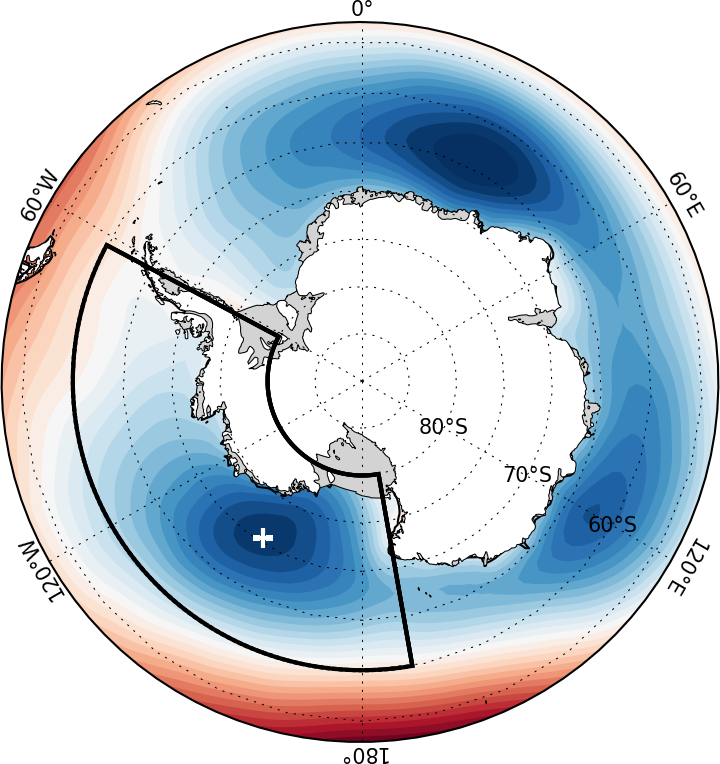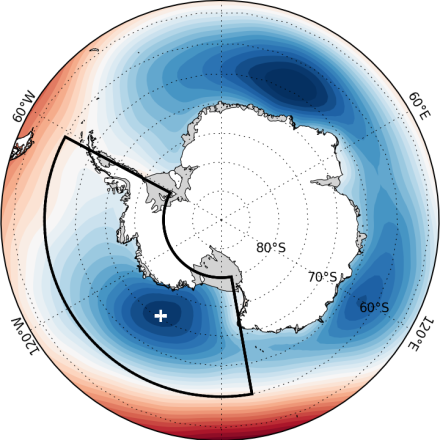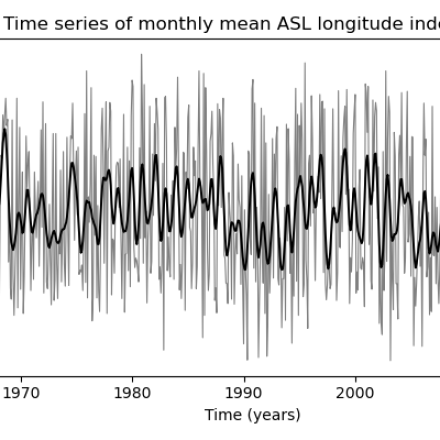Amundsen Sea Low indices

The Amundsen Sea Low (ASL) is a climatological low pressure center located over the extreme southern Pacific Ocean, off the coast of West Antarctica. Atmospheric variability in this region is larger than anywhere else in the Southern Hemisphere, and exhibits significant correlations with both the Southern Annular Mode (SAM) and ENSO. Given its linkages to basin-wide ENSO variability, the ASL may be thought of as a Southern Hemisphere analog to the Aleutian Low (see North Pacific Index). The ASL plays a significant role in the climate variability of West Antarctica and the adjacent oceanic environment. Due to the extreme variability in the ASL region, and the seasonal migration of the ASL's low-pressure center, defining a single index of the ASL is challenging. A consistent set of indices of the ASL, including its absolute and relative central pressure, and the latitude and longitude of these central pressures, has been derived from the ECMWF reanalysis. The term Amundsen-Bellingshausen Seas Low (ABSL) is another name for the ASL.
Key Strengths
Captures a large fraction of atmospheric variability in the most dynamic region of the Southern Hemisphere
Correlates with anomalies in winds, sea ice, air temperatures and other variables, giving confidence in its robustness and relevance to regional climate variability
Key Limitations
Difficult to quantify the strength of the ASL due to large background variability
Short record length due to limited observations and the lack of long-term, reliable atmospheric reanalysis
Few in-situ data available to assess the reliability of the ASL indices; spurious variability and trends could arise from the use of atmospheric reanalysis
Expert Developer Guidance
The following was contributed by Dr. Scott Hosking of the British Antarctic Survey, January, 2016 (updated 14 Janurary 2020 and 5 December 2022):
The Amundsen Sea Low is a climatological low pressure system located in the Pacific sector of the Southern Ocean. In this sector, variability in sea-level pressure is greater than anywhere in the Southern Hemisphere making it challenging to isolate local fluctuations in the ASL from larger- scale shifts in atmospheric pressure. The position and strength of the ASL are key drivers of regional change over West Antarctica (Hosking et al., 2013; Coggins and McDonald, 2015).
There has been much recent interest in the ASL because (i) rapid retreat of Pine Island and Thwaites glaciers (McMillan et al, 2015), (ii) observed rapid warming over central West Antarctica (Bromwich et al., 2012), and (iii) increase in snowfall in coastal West Antarctica (Thomas et al., 2015).
Version 2 differs slightly from that described in Hosking et al. [2013] which defined the location of the ASL as the point of lowest central pressure within the ASL sector region. This updated methodology ensures that the ASL is not falsely identified in cases where there is no local minima within the defined boundaries (as is the case in some CMIP5 models). In any case, when applied to the ERA-Interim reanalysis the results are relatively insensitive to the ASL detection method employed.
Version 3 uses an updated codebase written in Python and adopts ERA5 as the data source, which allows the indices to extend from January, 1959 to the near-present.
The dataset website https://www.bas.ac.uk/data/absl/ has monthly, seasonal and annual data. Note that the seasonal and annual indices are computed from their respective temporally averaged two-dimensional surface pressure fields. They are not the average of the three (or twelve) points from the monthly indices. ##
Cite this page
Acknowledgement of any material taken from or knowledge gained from this page is appreciated:
Hosking, Scott & National Center for Atmospheric Research Staff (Eds). Last modified "The Climate Data Guide: Amundsen Sea Low indices .” Retrieved from https://climatedataguide.ucar.edu/climate-data/amundsen-sea-low-indices on 2025-12-14.
Citation of datasets is separate and should be done according to the data providers' instructions. If known to us, data citation instructions are given in the Data Access section, above.
Acknowledgement of the Climate Data Guide project is also appreciated:
Schneider, D. P., C. Deser, J. Fasullo, and K. E. Trenberth, 2013: Climate Data Guide Spurs Discovery and Understanding. Eos Trans. AGU, 94, 121–122, https://doi.org/10.1002/2013eo130001

